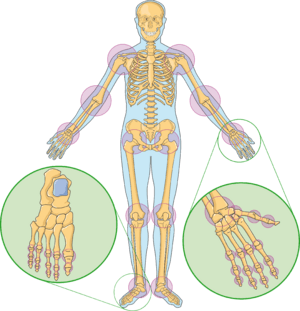Joint facts for kids
A joint is a special place where two or more bones meet in your body. Think of them as the connections that let your body move! Without joints, you wouldn't be able to bend your arm, walk, or even nod your head. They also help hold your bones together, giving your body support.
Between the bones in a joint, there's often a smooth, rubbery material called cartilage. Cartilage acts like a cushion, helping the bones glide past each other easily and making movement smooth and flexible.
Scientists classify joints in different ways. One way is by how the bones connect. Another way is by how much movement the joint allows.
Contents
How Joints Work and Are Grouped
Joints can be grouped based on how many bones meet there or if they have extra parts inside.
Simple and Complex Joints
- Simple joint: This is where just two bones meet. An example is your shoulder joint or your hip joint.
- Compound joint: This type of joint involves three or more bones meeting. Your wrist joint is a good example.
- Complex joint: These joints have two or more bones meeting, plus an extra cushion inside called an articular disc or meniscus. Your knee joint is a great example of a complex joint. The meniscus helps absorb shock and makes the joint more stable.
Where Are Joints Found?
You have many joints all over your body, allowing for all sorts of movements. Here are some of the main groups of joints:
- Joints in your hands: These allow you to grip, write, and do many detailed tasks.
- Elbow joints: These let you bend and straighten your arm.
- Wrist joints: These allow your hand to move up, down, and side to side.
- Shoulder blade joints: These connect your collarbone to your breastbone.
- Spine joints: These are between the bones in your back, letting you twist and bend.
- Jaw joints: These are on either side of your head, allowing you to open and close your mouth to talk and chew.
- Pelvis joints: These connect your spine to your hip bones.
- Hip joints: These are strong ball-and-socket joints that let your legs move in many directions.
- Knee joints: These are the largest joints in your body, allowing your legs to bend and straighten.
- Joints in your feet: These help you walk, run, and balance.
Images for kids
See also
 In Spanish: Articulación (anatomía) para niños
In Spanish: Articulación (anatomía) para niños




